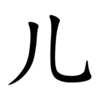儿
Appearance
(Redirected from ⼉)
| ||||||||
| ||||||||
Translingual
[edit]| Traditional | 兒 |
|---|---|
| Shinjitai | 児 |
| Simplified | 儿 |
| Stroke order | |||
|---|---|---|---|
| Stroke order | |||
|---|---|---|---|

| |||
Han character
[edit]儿 (Kangxi radical 10, 儿+0, 2 strokes, cangjie input 中山 (LU), four-corner 22010, composition ⿰丿乚)
- Kangxi radical #10, ⼉.
Derived characters
[edit]Related characters
[edit]- 兒 (Traditional form of 儿)
Descendants
[edit]References
[edit]- Kangxi Dictionary: page 123, character 1
- Dai Kanwa Jiten: character 1336
- Dae Jaweon: page 257, character 21
- Hanyu Da Zidian (first edition): volume 1, page 264, character 4
- Unihan data for U+513F
Chinese
[edit]Glyph origin
[edit]| Historical forms of the character 儿 | ||||
|---|---|---|---|---|
| Shang | Western Zhou | Shuowen Jiezi (compiled in Han) | Liushutong (compiled in Ming) | |
| Bronze inscriptions | Oracle bone script | Bronze inscriptions | Small seal script | Transcribed ancient scripts |

|

|

|

|

|
Pictogram (象形) – a standing person. A radical form of 人 (rén).
Also simplified from 兒 (elimination of 臼).
In the character 亮, the standing person 儿 was corrupted into 几. Unrelated to 匹.
Etymology 1
[edit]| For pronunciation and definitions of 儿 – see 兒 (“child; one's own child; son; etc.”). (This character is the simplified form of 兒). |
Notes:
|
Usage notes
[edit]- May be used to specially write erhua (or the rhotic sound) in traditional Chinese, in contrast with 兒/儿 (ér, “child”).
Etymology 2
[edit]| For pronunciation and definitions of 儿 – see 人 (“man; person; people; a person associated with a particular identity or trait; -er; etc.”). (This character is a variant form of 人). |
Japanese
[edit]Kanji
[edit]儿
- Kangxi radical for leg
Readings
[edit]Usage notes
[edit]儿 appears only as a radical in Japanese.
Korean
[edit]Hanja
[edit]References
[edit]- 국제퇴계학회 대구경북지부 (國際退溪學會 大邱慶北支部) (2007). Digital Hanja Dictionary, 전자사전/電子字典. [1]
Vietnamese
[edit]Han character
[edit]儿: Hán Nôm readings: nhân, nhi
Noun
[edit]儿
Usage notes
[edit]Appears only as a radical.
References
[edit]Categories:
- CJK Unified Ideographs block
- Han script characters
- Kangxi Radicals block
- CJKV characters simplified differently in Japan and China
- Han character radicals
- Translingual lemmas
- Translingual symbols
- Han pictograms
- CJKV simplified characters
- Chinese lemmas
- Mandarin lemmas
- Sichuanese lemmas
- Dungan lemmas
- Cantonese lemmas
- Taishanese lemmas
- Gan lemmas
- Hakka lemmas
- Jin lemmas
- Northern Min lemmas
- Eastern Min lemmas
- Hokkien lemmas
- Teochew lemmas
- Puxian Min lemmas
- Wu lemmas
- Xiang lemmas
- Middle Chinese lemmas
- Old Chinese lemmas
- Chinese hanzi
- Mandarin hanzi
- Sichuanese hanzi
- Dungan hanzi
- Cantonese hanzi
- Taishanese hanzi
- Gan hanzi
- Hakka hanzi
- Jin hanzi
- Northern Min hanzi
- Eastern Min hanzi
- Hokkien hanzi
- Teochew hanzi
- Puxian Min hanzi
- Wu hanzi
- Xiang hanzi
- Middle Chinese hanzi
- Old Chinese hanzi
- Chinese nouns
- Mandarin nouns
- Sichuanese nouns
- Dungan nouns
- Cantonese nouns
- Taishanese nouns
- Gan nouns
- Hakka nouns
- Jin nouns
- Northern Min nouns
- Eastern Min nouns
- Hokkien nouns
- Teochew nouns
- Puxian Min nouns
- Wu nouns
- Xiang nouns
- Middle Chinese nouns
- Old Chinese nouns
- Chinese terms spelled with 儿
- Chinese simplified forms
- Beginning Mandarin
- zh:Hominids
- zh:People
- Leizhou Min lemmas
- Southern Pinghua lemmas
- Leizhou Min hanzi
- Southern Pinghua hanzi
- Leizhou Min nouns
- Southern Pinghua nouns
- Chinese adjectives
- Mandarin adjectives
- Sichuanese adjectives
- Dungan adjectives
- Cantonese adjectives
- Taishanese adjectives
- Gan adjectives
- Hakka adjectives
- Jin adjectives
- Northern Min adjectives
- Eastern Min adjectives
- Hokkien adjectives
- Teochew adjectives
- Leizhou Min adjectives
- Puxian Min adjectives
- Southern Pinghua adjectives
- Wu adjectives
- Xiang adjectives
- Middle Chinese adjectives
- Old Chinese adjectives
- Chinese pronouns
- Mandarin pronouns
- Chinese proper nouns
- Mandarin proper nouns
- Sichuanese proper nouns
- Dungan proper nouns
- Cantonese proper nouns
- Taishanese proper nouns
- Gan proper nouns
- Hakka proper nouns
- Jin proper nouns
- Northern Min proper nouns
- Eastern Min proper nouns
- Hokkien proper nouns
- Teochew proper nouns
- Leizhou Min proper nouns
- Puxian Min proper nouns
- Southern Pinghua proper nouns
- Wu proper nouns
- Xiang proper nouns
- Middle Chinese proper nouns
- Old Chinese proper nouns
- Chinese variant forms
- Japanese kanji
- Japanese hyōgai kanji
- Japanese kanji with on reading じん
- Japanese kanji with on reading にん
- Japanese kanji with kun reading がい
- Japanese kanji with kun reading にんにょう
- Korean lemmas
- Korean hanja
- Vietnamese lemmas
- Vietnamese Han characters
- Vietnamese nouns
- Vietnamese nouns in Han script
- Vietnamese Chữ Hán

